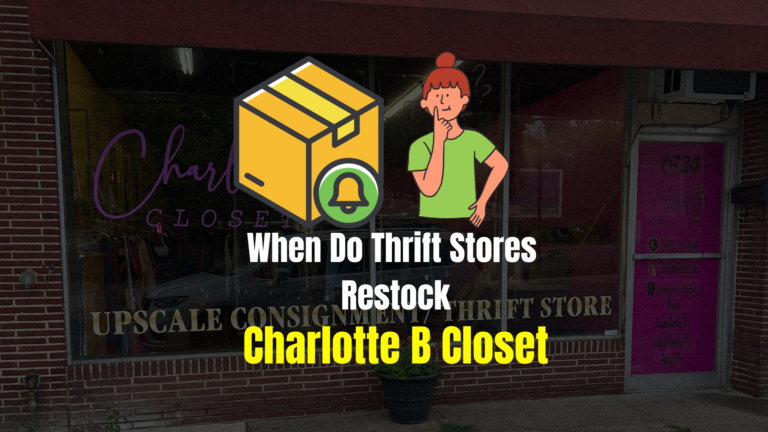How To Donate Clothes To Thrift Stores? – Detailed Guide
Have you ever considered the impact of your unused clothing collecting dust in your wardrobe?
Donating these items could be the solution, but the process isn’t always straightforward.
When considering donating clothes to thrift stores, it’s paramount to provide items in a wearable state without significant damage. Pre-washing them is a considerate step, as many thrift stores cannot handle bulk laundering.
Let’s dive into the comprehensive guide to ensure your generous act is both effective and meaningful.
How to Donate Clothes to Thrift Stores – Brief Guide
Donating clothes to thrift stores is more than just a charitable act; it’s an opportunity to contribute to sustainability and community welfare. Learn more about how thrift stores handle used clothes.
Begin by selecting clothes in good condition and free from noticeable damage. It’s beneficial to wash these items beforehand, considering that thrift stores often don’t have the means to clean every donation they receive.
Familiarize yourself with the specific policies of your chosen thrift store, as each may have unique guidelines.
By being meticulous in your preparation and understanding the intricacies of the donation process, your contributions can serve others effectively and find a new purpose.
Donating Your Wardrobe to Thrift Shops: Easy Steps to Follow
Donating clothes to thrift stores is more than just a simple act of decluttering; it’s a commendable gesture that bridges the gap between sustainability and philanthropy.
By offering your gently worn garments, you’re not only extending a helping hand to those in need but also playing a pivotal role in promoting a sustainable environment.
However, to maximize the impact of your contributions, understanding the intricacies of the donation process is paramount.
Understanding the Condition for Donations
The integrity and quality of your donated clothes can significantly influence their future use.
Why Quality Matters
The importance of donating clothes in good, wearable condition is a cornerstone of the donation process.
High-quality items not only ensure that thrift stores can provide valuable products to their patrons, but they also enhance the store’s reputation and trustworthiness.
After all, your donations are a reflection of your intention to genuinely help.
Assessing Your Donations
While the sentiment behind donating is crucial, the practical aspect revolves around the condition of the items. Clothing pieces with big stains, holes, or rips can be a disappointment for potential buyers. Always put yourself in the buyer’s shoes.
An item that doesn’t appeal to you due to noticeable damage is likely to be passed over by others as well. Thus, a thorough inspection of each clothing piece is essential before considering it for donation.
Preparation Before Donation
The preparatory phase is the unsung hero of the donation process. Properly preparing your items can make a world of difference.
The Importance of Cleanliness
The saying “Cleanliness is next to godliness” rings especially true in the context of donations. While the necessity of washing clothes before donating might seem trivial, it speaks volumes about the donor’s respect and consideration.
Clean clothes not only present better but also ensure that recipients receive items they can wear with pride.
Understanding Store Limitations
It’s essential to recognize the constraints thrift stores operate under. They are often inundated with donations, and the logistical challenge of cleaning every item is daunting. Thrift stores often lack the resources to launder every piece they receive.
Hence, by donating clean and fresh-smelling clothes, you’re not only enhancing the user experience for the next wearer but also significantly alleviating the operational burdens of the store.
Knowing the Thrift Store’s Policies
The world of thrift stores is diverse, with each store having its unique set of operations and policies.
Guidelines and Acceptance Criteria
It’s not uncommon for thrift stores to have specific guidelines concerning the types of clothes they accept.
Some might have stringent quality checks, while others might be more lenient. Familiarizing yourself with these guidelines can ensure your donations are always welcome.
Staying Updated
Thrift stores, like any other business, experience ebbs and flows in demand. There might be times when certain items are in higher demand, such as winter wear during colder months. Conversely, they might have an excess of specific garments at other times.
Being aware of these dynamics can make your donations more timely and relevant. A simple phone call or a glance at their website can keep you informed and help you tailor your donations accordingly.
What Type of Clothes Can You Donate to Thrift Stores?
Thrift stores serve as treasure troves for many, offering a variety of clothing options that cater to different tastes and needs.
As someone looking to contribute, understanding the types of clothes that are in high demand can ensure your donations find a new home swiftly.
Everyday Essentials
The bread and butter of thrift stores are the General Acceptance items. Think of the basics: shirts, pants, skirts, and dresses. These everyday essentials form the backbone of most people’s wardrobes and are perennially in demand.
Given their versatile nature, such items are always a welcome addition to thrift store collections.
Seasonal Staples
With changing seasons come changing wardrobes. Items such as jackets, sweaters, and swimwear become particularly sought after during specific times of the year.
By donating these seasonal wear items, you’re ensuring that someone can stay warm during the winter or enjoy a summer swim without breaking the bank.
Specialty Sections
Beyond the every day and seasonal items, thrift stores also have Special Categories that cater to unique needs. Formal wear items, including suits, ties, and evening gowns, often find themselves in a dedicated section, providing affordable options for those attending special occasions.
Moreover, accessories like belts, hats, and scarves not only complete an outfit but also add a dash of style. These items, though sometimes overlooked, can significantly elevate a look and are always in demand.
What Type of Clothes Should You Avoid Donating to Thrift Stores
While thrift stores aim to offer a wide variety, there are certain items that may not be ideal for donation. Understanding these limitations ensures that your contributions are meaningful and reduces the operational challenges for the stores.
Quality Over Quantity
The adage “it’s the thought that counts” might not fully apply here. Damaged or Worn Out Items can be a challenge for thrift stores.
Clothing with irremovable stains, holes, or broken zippers might not find takers and could end up being a liability for the store. It’s always better to donate items that you’d consider buying yourself.
Safety First
The safety of the end consumer is paramount. Donating Recalled or Unsafe Items can pose significant risks. Especially when it comes to children’s wear, any clothing that doesn’t meet current safety standards should be avoided.
Remember, a donation should never compromise the well-being of the recipient.
Protecting Privacy
In today’s digital age, privacy has become more important than ever. Items with Sensitive Information, be it personal logos or identifiable information, should be left out of the donation box. It’s essential to ensure that your donation doesn’t inadvertently share personal details or affiliations.
Steps to Pack and Donate Clothes to Thrift Stores
Donating clothes to thrift stores is a multi-step process that goes beyond just selecting items from your wardrobe.
Proper preparation and understanding of the donation process can make your contribution more effective and beneficial for both the thrift store and its patrons.
Sorting and Selection
Before you even think about packing, the first crucial step is the Sorting and Selection process. It’s essential to be methodical and organized to ensure the quality of your donation.
Categorize Your Clothes
Begin by separating clothes based on their condition and type. This will give you a clear picture of what you have and which items are suitable for donation.
Create different piles: one for donation, one for recycling, and one for discarding. Such categorization ensures that only the best items make their way to the thrift store, maximizing the benefit for both the store and the end consumer.
Packing Clothes
Once you have your items sorted, the next step is to pack them properly to ensure they reach the thrift store in the best possible condition.
Choose the Right Packaging (H3)
Opt for sturdy boxes or durable bags when packing your clothes. This not only ensures the safety of the items but also eases the unpacking process for the thrift store.
If you’re donating a variety of clothing types, labelling the boxes can be a thoughtful touch. It assists the store in processing the donation faster and ensures that the items reach the right section without any mix-ups.
Choosing the Right Thrift Store
Not all thrift stores are the same. Each has its unique requirements, policies, and target audience.
Research Before Donation
Take some time to research local thrift stores and their donation policies. Understanding a store’s mission or the types of items they prioritize can help you tailor your donation for maximum impact.
For instance, specialty thrift stores might focus on designer items, vintage pieces, or specific categories. Donating relevant items to such stores can be more impactful and ensure that your items find a new home quickly.
Dropping Off Donations
The final step in the donation process is delivering your packed items to the thrift store.
Know the Logistics
Before heading out, it’s essential to find out the drop-off times and locations. Many thrift stores have designated hours and specific areas for accepting donations to streamline the process and ensure efficient handling.
Securing a Receipt
Lastly, always ensure getting a donation receipt if required. While this can offer potential tax benefits, it’s more than just a financial document. It serves as a testament to your generous act and a record of your contribution to the broader community.
Conclusion
Donating clothes to thrift stores is a noble endeavour, bridging the gap between sustainability and community support.
Donors can make a meaningful difference by ensuring that the items are of good quality, clean, and aligned with the store’s policies. Beyond the act of giving, it’s the thought, preparation, and understanding behind the donation that amplifies its impact.
So the next time you think of decluttering, remember the potential of your unused clothes to bring joy to someone else and contribute positively to the environment.
FAQs
What preparations should I make before donating clothes to thrift stores?
Before donating, ensure clothes are in wearable condition, free from significant damages, and pre-washed, as many thrift stores can’t manage extensive cleaning.
Are there specific types of clothes that thrift stores prefer or avoid?
Thrift stores commonly seek everyday wear and seasonal items but may decline clothes with visible damage, personal logos, or those not meeting safety standards.
How should I pack clothes for donation to ensure they’re accepted?
Use sturdy boxes or bags for packing, and if donating varied clothing types, consider labelling the boxes to facilitate easier processing at the store.
How do I choose the right thrift store for my clothing donation?
Research local thrift stores’ policies and missions. Some may have specific needs or focus on particular clothing categories, optimizing your donation’s impact.

Hi there, I’m Toni Whitten, but you might know me as LadyT. I’m a passionate entrepreneur and the proud owner of Charlotte B’s Closet, your go-to thrift store and upscale consignment.
Outside the store, I connect with the amazing women in my exclusive Facebook group, Housewives of Baltimore, boasting over 23k+ members.
In my free moments, I channel my passion for sharing genuine insights and helpful guides on various concerns through my blog at charlottebcloset.com.







